
1. GRADE5
1.1. DO YOU UNDERSTAND OURSELVES
1.1.1. COLLECTIVE DIVERSITY BRINGSA COLLECTIVE STRENGTH IMPORTANT FOR HUMANITY
1.1.1.1. ENGLISH
1.1.1.1.1. Importance of understanding our national heritage.
1.1.1.1.2. To learn about our unsung heroes and their lives.
1.1.1.1.3. Develop a sense of national love and patriotism.
1.1.1.1.4. Summarise the national heritage and culture of our country in their own words.
1.1.1.1.5. Different types of Pronouns and use them in effectiive writing.
1.1.1.1.6. Indulge into reading to develop critical thinking ability and enhance creativity.
1.1.1.1.7. To recognize pronouns and distinguish them from other parts of speech.
1.1.1.2. HINDI
1.1.1.2.1. संतुलित आहार से होने वाले लाभ|
1.1.1.2.2. लेखन कोशल द्वारा अपने मन व्यंजन बनाने की विधि का क्रमबंध वर्णन |
1.1.1.2.3. खान-पान में सुधार कर पाना|
1.1.1.2.4. पारिवारिक प्रेम- भाव को समझाना|
1.1.1.2.5. जीव-जंतु के प्रति प्रेम-भाव का अहसास
1.1.1.2.6. .विशेषण शब्दों को पाठ में से छांटकर उनका वर्गीकरण कर पाना
1.1.1.2.7. .कविता का सार लिख पाना
1.1.1.2.8. अपठित गद्यांश को समझ पाना व उत्तर लिखना
1.1.1.2.9. संतुलित आहार पर रचनात्मक लेखन द्वारा अपने विचार व्यक्त कर पाना
1.1.1.3. SCIENCE
1.1.1.3.1. How to keep oneself safe from diseases?
1.1.1.3.2. How Various communicable diseases spread
1.1.1.3.3. How to prevent onself from diseases
1.1.1.3.4. How Ayurveda can help us to be physically fit
1.1.1.3.5. How our kitchens shelf can protect us from common disease
1.1.1.3.6. what should be done to make our Immune system strong
1.1.1.4. MATHS
1.1.1.4.1. The myriad cells in the human body upto Crores and Millions
1.1.1.4.2. The number of people infected and recovered with Infectious diseases using the Concept of Addition and Subtraction.
1.1.1.4.3. Cultural Differences and similarities with respect to Addition and Subtraction
1.1.1.4.4. The importance of physical activities with respect to the calories burned per unit of time.
1.1.1.4.5. How to estimate the total bill in a Grocery Store before the checkout.
1.1.1.5. SOCIAL SCIENCE
1.1.1.5.1. 1How do cultures influence each other?
1.1.1.5.2. .How has modern technology
1.1.1.5.3. impacted culture change?
1.1.1.5.4. How does the interaction among
1.1.1.5.5. cultural groups Impact /change
1.1.1.5.6. food, clothing, thoughts and ideas.
1.1.1.5.7. Our own personal histories, backgrounds, and cultures
1.1.1.6. ICT
1.1.1.6.1. Types of diseases
1.1.1.6.2. research work on cullture and traditions
1.1.1.6.3. how to create a travelogue
1.1.1.7. VISUAL ARTS
1.1.1.7.1. How words can be represented in different ways 2. How topics of global importance are conveyed effectively by writing slogans
1.1.1.7.2. Various styles & ways of creating Slogans
1.1.1.7.3. How to expressively create slogans to promote tourism in different states of india
1.1.1.7.4. How to write slogans using different types of fonts
1.1.1.8. PERFORMING ARTS
1.1.1.8.1. how to showcase cultural diversity using different folk songs and dance
1.1.1.9. PHYSICAL EDUCATION
1.1.1.9.1. how fitness could be achieved through different sports
2. TRANSDISCIPLINARY UNITS OF ENQUIERY
3. HOLISTIC LEARNING S
4. DEVELOPMENT OF 21ST CENTURY SKILLS
5. LINKAGE WITH INDIAN ROOTS
6. DEVELOPMENT OF 21ST CENTURY SKILLS
7. DO YOU UNDERSTAND OURSELVES
7.1. HEALTHY ME LEADS TO HEALTHY UNIVERSE
7.1.1. ENGLISH
7.1.1.1. Importance of mental health and well-being.
7.1.1.2. How positive thoughts help us to live a healthy and stressfree life.
7.1.1.3. To express oneself properly and explicitly.
7.1.1.4. To be able to choose our own future profession.
7.1.1.5. Use nouns (words) in sentences while upholding grammatical integrity.
7.1.1.6. What is the role of a noun and be able to identify nouns in sentences.
7.1.1.7. Read to activate and reinforce other skills.
7.1.2. HINDI
7.1.2.1. पारिवारिक जिम्मेदारी व सहभागिता का अहसास |
7.1.2.2. माँ की देखभाल करने का मह्त्त्व एवं इसके उपाय |
7.1.2.3. संकल्पनात्मक समझ प्रदर्शित कर पाना तथा अपनी राय देना |
7.1.2.4. खाद्य श्रृखला का मह्त्त्व |
7.1.2.5. सूझ बूझ व सतर्कता का अहसास |
7.1.2.6. अतीत की स्मृतियों से भावुकता और दृढ संकल्प का भाव |
7.1.2.7. पाठ से संज्ञा शब्दों का वर्गीकरण
7.1.2.8. अपठित गद्यांश को समझ पाना व उत्तर लिखना
7.1.3. SCIENCE
7.1.3.1. Which factors affect health?
7.1.3.2. How do we get the proper nutrients for health? Ways in which we can improve our health?
7.1.3.3. How the surroundings in which we live affect our health?
7.1.3.4. Why digestive system is important for our health?
7.1.3.5. The way of designing a balanced diet plan
7.1.4. MATHS
7.1.4.1. The quantity of food crops produced in India using Large numbers
7.1.4.2. How to Compare the different nutrients with respect to their daily energy requirements?
7.1.4.3. The importance of physical activities with respect to the calories consumed
7.1.4.4. The use of different nutritional labels while planning a Healthy meal using the concept of Addition
7.1.4.4.1. The optimal use of Ferilizers in Agriculture using numbers
7.1.4.5. Differences in the Calorie intake vs Calorie burned
7.1.5. SOCIAL SCIENCE
7.1.5.1. From where do we get nutrients?
7.1.5.2. How did we start farming?
7.1.5.3. Which festivals are linked to harvest?
7.1.5.4. Why do we have different types of crops?
7.1.5.5. How the crops are cultivated?
7.1.6. ICT
7.1.6.1. How to research on different agricultural practices
7.1.6.2. how to present data using table through Ms Word
7.1.6.3. How to Graphically represent and analyse data
7.1.7. VISUAL ARTS
7.1.7.1. Various styles & ways of creating Slogans
7.1.7.2. How to represent thoughts in way of slogan
7.1.7.3. How to write slogan in expressive ways
7.1.8. PERFORMING ARTS
7.1.8.1. How to showcase problem of malnutrition and ways to solve the the problem by Drama depiction
7.1.9. PHYSICAL EDUCATION
7.1.9.1. how can we keep our body fit by different sports
